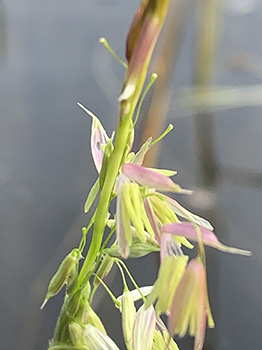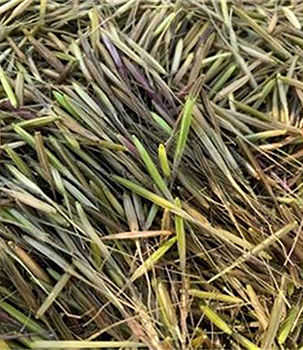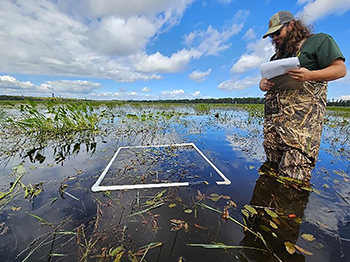Bringing back ‘the good berry’ – efforts to restore manoomin, Michigan’s native grain
By CASEY WARNER
Marketing and communications coordinator
Michigan Department of Natural Resources
“Manoomin (Zizania palustris and Zizania aquatica), also known as Michigan wild rice, is designated as the official native grain of this state. Let it be known that manoomin is a sacred and important component to many wetlands and has a cultural significance to Indigenous people of this state.”
So reads Public Act 247, passed by the Michigan Legislature and signed by Gov. Gretchen Whitmer in November 2023, designating manoomin the state’s official native grain.

The first native grain designation in the United States, this legislation is part of a statewide effort among tribal communities and state and federal government agencies to elevate awareness about wild rice conservation and restoration.
The Michigan Wild Rice Initiative brings together specialists and managers from all 12 of the state’s federally recognized tribes, multiple state departments and federal agencies, seeking to protect, preserve and restore manoomin and its culture in Michigan to enhance ecosystem health and benefit present and future generations.
Native to the Great Lakes region and parts of Canada, manoomin – which translates to “the good berry” in Ojibwe – is a grain-producing, aquatic grass. It grows to 6-10 feet tall in the shallow, quiet waters of marshes, inland lakes and slowly moving streams.
An article in Native News Online explains: “Manoomin is a culturally significant plant to the Anishinaabek (Odawa, Ojibwe and Potawatomi) and is directly linked to their migration from the northeastern coast to the Great Lakes region several hundred years ago.
In the Great Lakes region, manoomin plays a major role in the Indigenous food sovereignty movement. Manoomin is an important part of Michigan’s ecological landscape, providing valuable food and cover for waterfowl, mammals, fish, amphibians and bird species.”
|

Wild rice was once widespread, with some beds reaching thousands of acres in size, but it has declined significantly in the last 175 years.
“Today, there are less than two hundred (mostly small) manoomin beds across the state, with only one of the historic large beds remaining. Logging, the dredging and draining of wetlands, dams and pollution all played a role in the historic decline of the inland beds,” the Native News Online article states.
Learn more about the history of manoomin in a brochure from the Great Lakes Indian Fish and Wildlife Commission, one of the Michigan Wild Rice Initiative partners.
As another of the initiative’s partners, the Michigan Department of Natural Resources has embarked on wild rice restoration efforts over the past several years.
“Once abundant throughout Michigan, wild rice faces threats from climate change, habitat loss, uninformed harvesting practices, degraded water quality and other factors,” states the 2023 DNR Wildlife Division Annual Report, which goes on to detail some of the department’s wild rice planting accomplishments last year.
|

In 2021, DNR wildlife biologists Brian Roell and Kristie Sitar received a U.S. Environmental Protection Agency grant to plant wild rice in northern floodings along Lake Superior.
The main goal was to plant wild rice for three consecutive years at four locations – three in Marquette County and one in Luce County – at a rate of at least 50 pounds per acre in suitable flooding habitats.
“We did preassessments of water depth, substrate and plant competition to choose the best locations for the rice,” Sitar, who works out of the DNR Newberry Field Office, said.
The DNR has obtained rice for this project through an annual memorandum of understanding with the Keweenaw Bay Indian Community.
|

In 2021, the first year of intended planting, the project team could not get seed due to dry conditions at the rice lakes in Minnesota, so the grant got extended for another year to allow them to finish seeding for three years as planned.
“After the first year of planting, we did germination assessments at each planting location to see how the previous seeding had progressed,” Sitar said.
In 2022, 33 acres and 2,359 pounds of rice were planted, and in 2023, 21 acres and 1,986 pounds of rice were planted as part of this project.
“This fall will be our third year planting in these locations,” Sitar said. “The intention is to continue to plant wild rice in these locations to establish self-propagating locations.”
|

The grant also allowed for other work including dredging, invasive species inventories and phragmites treatment, baseline marsh bird surveys, producing outreach materials and developing a wildlife/water quality activity trail.
In addition to the grant project, the DNR also has been planting wild rice at other locations in the eastern Upper Peninsula: 200-1,060 pounds per year at the Dollarville flooding in Luce County since 2016 and 50-430 pounds per year at the Black Creek Flooding in Mackinac County since 2018 (except for 2021, when rice was unavailable).
“Eastern U.P. (DNR) staff have also had discussions and meetings with the tribes to explore how to continue to work together to reestablish rice in the region,” Sitar said.
In the western U.P., the DNR Wildlife Division has been partnering with the Keweenaw Bay Indian Community for nearly a decade on wild rice restoration efforts. Recent work includes a total of 10,278 pounds of wild rice seeded at 11 sites on public and tribal lands in Baraga and Houghton counties in 2023.
Find more information about the DNR’s work to take care of Michigan’s wildlife and their habitats at Michigan.gov/Wildlife.
Learn more about the cultural and ecological significance of wild rice during the free webinar “Tribal Wisdom on Nibi and Ecosystems – Manoomin and the Circle of Life” from 1 to 2:30 p.m. Tuesday, June 4, presented by the Michigan Department of Environment, Great Lakes, and Energy as part of its annual Great Lakes and Fresh Water Week celebration.
|
Check out previous Showcasing the DNR stories in our archive at Michigan.gov/DNRStories. To subscribe to upcoming Showcasing articles, sign up for free email delivery at Michigan.gov/DNREmail.
Note to editors: Contact: John Pepin, Showcasing the DNR series editor, 906-226-1352. Accompanying photos and a text-only version of this story are available below for download. Caption information follows. Credit Michigan Department of Natural Resources, unless otherwise noted.
Text-only version of this story.
Boat: Bags of wild rice seed loaded into a flat-bottomed boat for planting at Blind Sucker Flooding in Luce County.
Flowers: A close-up view of Michigan wild rice flowers.
Germination: Jon Vigilant, DNR wildlife employee from Marquette, assessing wild rice seed germination at Sand River Flooding in Marquette County.
Mud Lake 2018 and Mud Lake 2023: Wild rice planted on Mud Lake in the Dollarville Flooding in Luce County is shown in 2018 and 2023.
Quadrant: One of the square-meter quadrants used for assessing wild rice germination.
Seed: Wild rice seed ready for planting.
Seeding_Harlow: DNR wildlife technician Caleb Eckloff is shown seeding wild rice into Harlow Lake in Marquette County.
Seeding_Blind Sucker: Volunteer Evan Griffis and DNR wildlife employee John Sierkierski seeding wild rice into the Blind Sucker Flooding in Luce County.
|